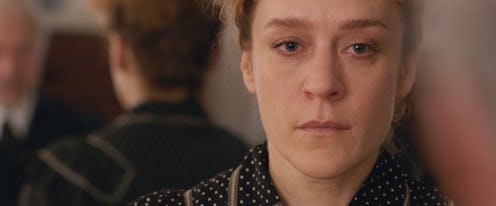Entertainment
The New Lizzie Borden Movie Presents A Compelling Theory About Those Infamous Murders

You've probably heard of Lizzie Borden, the infamous suspected ax murderer who allegedly killed her father and stepmother in the late 1800s. There have been a lot of movies, shows, and books about her over the years, and the latest is Lizzie, starring Chloë Sevigny in the title role. Since theories about the murders are all over the place, after seeing (or even just hearing about) this film, it's no surprise if people want to know how accurate Lizzie is.
It's a hard question to answer since no one knows what really happened on August 4, 1892 when Abby and Andrew Borden were murdered in their home. The known facts are that on the morning of August 4, the family's maid, Bridget Sullivan, was washing windows. At one point she came inside to let Andrew in front door of the house since he'd gotten locked out after going to run some errands. Sullivan soon went up to her room to take a nap and not long after Borden screamed to her, "Come down quick! Father's dead! Somebody's come in and killed him." A doctor was tracked down and a neighbor came over after hearing the commotion. Sullivan then found Abby dead upstairs. Borden was the only suspect put on trial, and she was acquitted by the jury after a very short deliberation.
Lizzie shows all of this (save the neighbor and doctor coming over), so it's accurate on those points, but it also shows the planning of the murders and the actual killings taking place, the accuracy of which cannot be known. The film puts forth that Borden committed both murders (which is pretty widely believed even though she was acquitted) and also that Sullivan was her lover turned accomplice.
In the movie, Sullivan agrees to help Borden kill Abby and Andrew with the motives being a combination of money (Borden's inheritance) and revenge (Andrew abusing Sullivan and mistreating Borden). The plan is that Borden will kill Abby and then Sullivan will kill Andrew, but Sullivan ends up not being able to go through with it at the last minute, so Borden takes the ax from her and kills Andrew herself. The women plan to commit the murders while nude to avoid bloody clothing becoming evidence. When Borden takes the ax from Sullivan, though, she is wearing a dress, which connects to the real life story that Borden burned a dress a few days after the murders. (She claimed it was because she got paint on it.)
After the murders, the film then picks up at the part where Borden calls to Sullivan about finding her father dead, positing that at that point they decided to treat the murders as if they hadn't been involved in them at all.
When Borden was let free in June 1983, she decided to remain in Fall River, Massachusetts. Sullivan ended up moving to Montana, where she would die in 1948 at age 66.
The way the murders happened in the film is based on a theory, and this is also the case with its depiction of Sullivan and Borden's relationship. In Lizzie, they are friends who become lovers, and this is not a known fact, just something that has been theorized. The movie also shows that Andrew sexually abused Sullivan, which was not confirmed and was not mentioned in Sullivan's testimony, which can still be read today.
Lizzie does not show much about Borden's relationship with Abby, which is something star and producer Sevigny was not happy about. Sevigny also hoped the movie would show more of what was going on in Borden's mind. When speaking Huffington Post about director Craig William Macneill's decisions with the film, she said, "There was more to the relationships that made them more complicated, and also then informed why Lizzie [commits the murders]. Now it’s a little more vague than what Bryce [Kass, the screenwriter] and I intended originally to do."
What's not vague is the particular theory that this film set out to explore. It puts forth one option for how things happened, rather than presenting a few scenarios. This theory might not be accurate — no one can know — but it is an interesting take on the case and adds yet another layer to Lizzie Borden's story.